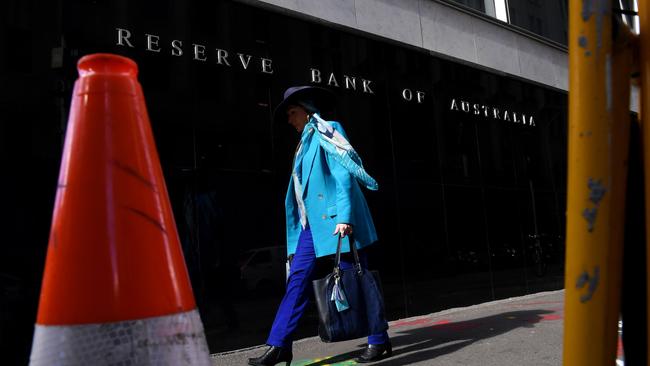Westpac expects RBA cash rate to top out at 2.6pc next year
Westpac has increased its interest rate forecasts after predicting a faster pace of rate hikes by the US Federal Reserve as it responds to surging inflation and inflation expectations.

Westpac has increased its interest rate forecasts after predicting a faster pace of rate hikes by the US Federal Reserve as it responds to surging inflation and inflation expectations.
Westpac chief economist Bill Evans now sees Australia’s cash rate peaking at 2.6 per cent in February, up from his previous forecast of 2.35 per cent.
After slashing the cash rate to a record low of 10 basis points during the pandemic, the Reserve Bank has increased the key monetary policy rate to 85 basis points in the past two months.
RBA Governor Philip Lowe said the “resilience of the economy and higher inflation mean that this extraordinary support is no longer needed” and the bank “expects to take further steps in the process of normalising monetary conditions in Australia over the months ahead”.
CPI inflation for the March quarter hit 5.1 per cent year-on-year, well above the RBA’s 2-3 per cent target.
It came as Australian household wealth rose to a fresh record high on the back of rising property prices. Data from the Bureau of Statistics shows total household wealth increased 1.2 per cent or $173bn in the quarter to $14.9 trillion, while wealth per capita hit a record high of $574,807.
Evans’ forecast for the peak of the cash rate is still below market-implied levels of 3.3 per cent by December 2022 and about 4 per cent by July 2023. Market-implied rate hikes fell sharply in the last week as recession fears increased and Lowe says he expects the RBA to decide on a 25 or 50 basis point rate hike (rather than 75) next month.
Evans sees a 50 basis point rate hike in August as well as 50 basis points in July. He expects a “pause” in September, and two final 25 basis point hikes in December and January.
“Moving swiftly to reverse what is clearly an over-stimulatory policy setting and then pausing before moving into the ‘contractionary zone’ is the best approach, and one that is most likely to avoid the damaging overshoot we are forecasting for the FOMC,” Evans says. “Such a strategy would also assist in the central objective of the tightening cycle: to signal clearly to economic agents – households and trade unions in particular – that the Reserve Bank is committed to returning inflation to target over the medium term, thereby containing any lift in inflation expectations.”

A swift move to 1.85 per cent would “only restore the cash rate to slightly above the 1.5 per cent that held for nearly three years between August 2016 and May 2019, when inflation persistently undershot the bank’s 2-3 per cent target.
Evans expects the RBA’s August meeting to “respond to what is expected to be a very unsettling June quarter inflation report” on July 27, in which headline inflation is expected to rise 1.5 per cent in the quarter taking annual inflation to 5.8 per cent year-on-year.
Underlying “trimmed mean” inflation is expected to rise 1.2 per cent, lifting annual core inflation from 3.7 to 4.5 per cent year-on-year, and Evans sees “upside risk” on his inflation forecasts.
After responding firmly to a further rise in inflation – by moving the cash rate into the “neutral zone” and signalling a clear commitment to containing inflation and inflationary expectations – he expects the RBA to “pause” its monetary policy tightening. “We expect the pause for two months to assess the impact of the rapid cumulative 175 basis point increase over four months,” he says.
A quarterly report from the Council of Financial Regulators says it “will be closely monitoring the effects of rising interest rates on the household sector”.
However members “emphasised the additional resilience provided by the substantial housing equity and payment buffers built up by households since the onset of the pandemic”.
Evans’ case remains that, after a worrisome September quarter inflation report that he expects on October 26, a further tightening will be “seen as necessary” at the RBA’s November meeting.
Annual headline inflation is expected to be steady at 5.7 per cent year-on-year in the September quarter – partly due to state government subsidies temporarily forestalling the effect of a big rise in electricity costs – but underlying inflation is expected to have lifted from 4.5 to 4.8 per cent.
Westpac’s forecast of underlying inflation, if achieved, would be the highest rate of core inflation in Australia since the Reserve Bank began its inflation targeting policy in the early 1990s.
“The next move would put policy into the contractionary zone,” Evans says. “As such, it would be prudent to revert to proceeding in 25 basis point increments given the added uncertainty around the impact of each move.”
The profile of rates increases he expects would mark the second fastest tightening cycle since 1990, exceeded only by a 275 basis point increase over five meetings in the second half of 1994.
But Evans expects that, along with the clear slowing in the economy over the December and March quarters, the March quarter inflation report will provide evidence that the slowing in demand and the freeing up of supply has brought demand and supply into closer alignment, easing inflation pressures.
“That evidence would be available by the May 2023 board meeting, allowing the board to move to a ‘wait and see’ approach, potentially signalling the end of the tightening cycle with the cash rate having reached 2.6 per cent.”







To join the conversation, please log in. Don't have an account? Register
Join the conversation, you are commenting as Logout